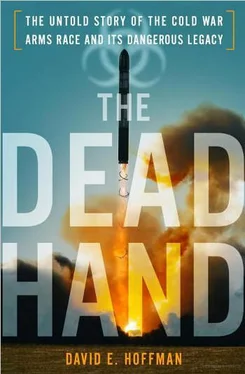“We have already reached accord on much,” he told the journalists. “We have come a long way.” 69
————— 12 —————
FAREWELL TO ARMS
When George Shultz entered the pressroom on the evening of October 12, 1986, in Reykjavik, the secretary of state had disappointment etched in his face. Shultz opened his remarks with a strained voice. Max Kampelman, one of the American negotiators, was nearly in tears. The two leaders had come so close to a deal—and then departed empty-handed. The Washington Post carried a two-line banner headline the next morning: “Reagan-Gorbachev Summit Talks Collapse as Deadlock on SDI Wipes Out Other Gains.” Lou Cannon of the Post wrote that the summit ended “gloomily” and Gorbachev was described as giving a “bleak assessment” of the prospects for the future. But in capturing the drama of the moment, the press corps failed to grasp the long-term significance. Reagan and Gorbachev had debated, negotiated and in some cases reached agreement on the most sweeping disarmament proposals of the nuclear age. Both men realized very quickly they had reached a turning point in the Cold War. “Let us not despair,” Gorbachev told Chernyaev on the plane home to Moscow, saying he was still a big optimist. 1
Gorbachev reported to the Politburo two days later that the negotiating positions of the past had been “buried” once and for all. “A totally new situation has emerged,” he said, a “new, more elevated plateau from which we now have to begin a struggle for liquidation and complete ban on nuclear arms… This is a strong position. It reflects new thinking.” 2Chernyaev quoted Gorbachev as saying in the weeks that followed: “Before, we were talking about limitations on nuclear arms. Now we are talking about their reduction and elimination.” 3
Yet for all his optimism, Gorbachev knew a huge opportunity had been missed at Reykjavik. Not a single nuclear warhead had yet been dismantled, not a single treaty had been signed. Gorbachev needed results—and he felt time was slipping away. His dreams of nuclear disarmament were driven by very genuine fears of the danger. But there were other, pragmatic reasons, too. His tentative efforts at perestroika had failed to improve Soviet living conditions, and a gathering storm loomed over the economy. Oil prices tumbled in 1986, and so did hard currency revenues. The country was forced to import grain and meat and borrow heavily from abroad. A huge budget deficit opened up. Gorbachev acknowledged at a Politburo meeting: “Now the situation has us all by the throat.” 4
The overriding goal for Gorbachev was to transform the Reykjavik summit talk into concrete gains that might alleviate the military burden. Gorbachev seized the brake handles on the hurtling locomotive and threw himself into bringing about real change. Internal documents and evidence from memoirs suggest that it was not at all evident to the generals, or the weapons builders, or the old guard in the leadership, how radical a turnabout Gorbachev was contemplating after Reykjavik. After Gorbachev’s report to the Politburo, the ruling body acted cautiously. They issued an instruction to the military to prepare for possible deep cuts in strategic arms. But at the same time, the Politburo considered it entirely possible the Soviet Union would remain locked in Cold War competition, that there would be no deep cuts and they would have to retaliate against Reagan’s Strategic Defense Initiative, “especially its outer space components.” For all Gorbachev’s enthusiasm, they thought, the arms race might not end soon. 5
Although the Politburo members did not see where Gorbachev was headed, Akhromeyev, the chief of the General Staff, most certainly did. Akhromeyev was above reproach by the military elite for his long service to the country, and he gave Gorbachev the cover and legitimacy he needed to attempt a radical farewell to arms.
In 1986, after helping Gorbachev with the January 15 proposal to eliminate all nuclear weapons, Akhromeyev concluded that it was time to create a new Soviet military doctrine to match Gorbachev’s era.
The military doctrine was the foundation of all the assumptions, goals and preparations of the sprawling Soviet defense machine, from frontline troops to the General Staff, from research institutes to arms factories. The old doctrine declared that the United States and NATO were the main adversaries of the Soviet Union; that the Soviet Union must strive for parity with the West in weapons. In the late autumn and early winter of 1986, Akhromeyev tore up the old doctrine. This was an excruciatingly difficult moment for him, requiring a reversal of all he had been taught. “The doctrine that had existed before 1986 was an indisputable truth for me and the General Staff,” he recalled. “It was bequeathed to us by the World War II commanders… who taught and molded me and people like me, whose names we pronounce when we take an oath to serve our Fatherland! How can all this be changed? Everything I had been taught for many years in the academies, on maneuvers. To change things I myself had been teaching to the younger generation of generals and officers, for many years already. A substantial segment of our military experience, theory and practice was being ditched.”
Just after Reykjavik, Akhromeyev delivered a lecture on the new doctrine at the Academy of the General Staff in Moscow, where the best and brightest officers studied. He spoke to an elite audience, which included military specialists, professors and strategists. The changes were stark. While the United States would still be the main adversary, Akhromeyev said, “we are prepared to dismantle the mechanism of military confrontation with the United States and NATO in Europe.” While a war would still be contemplated with nuclear and conventional weapons, he said, “we stand for complete liquidation of nuclear weapons in the world.” Instead of striving for parity, he said, the Soviet Union would reduce its forces, either by agreement or unilaterally if necessary.
“While I was speaking, there was absolute silence in the hall,” Akhromeyev recalled. “The faces reflected incomprehension, bewilderment and alarm.” When he was finished, “all restraints broke loose. The decorum of our military scientists was gone! Many of them seemed to forget that it was the head of the General Staff who was speaking to them. Accusations just short of treason were hurled at me. A number of points of the report were called erroneous and unacceptable.” What had taken months for Akhromeyev to think over was delivered in about ninety minutes. “One could understand why they were in a state of shock,” he said. “I had to answer questions for another two hours.” 6
A grand retreat had begun.
Right after the Reykjavik summit, Reagan was at the top of his game. In a nationally televised speech October 13 and in campaign appearances across the country before the November election, Reagan launched one of the most extraordinary—and persuasive—public relations campaigns of his presidency. He boasted that he had stood up to Gorbachev. On the campaign trail, he evoked enthusiastic cheers from audiences when he declared that at Iceland, “I just said, ‘No!’” Reagan portrayed his refusal to give up the Strategic Defense Initiative as a triumph, even though SDI did not even exist.
Soon, however, Reagan was plunged into a season of troubles. Serious questions were raised about what was actually said at Hofdi House. Gorbachev noted in a televised speech from Moscow on October 22 that he and Reagan had agreed to the complete elimination of all strategic offensive weapons by 1996. 7This seemed to differ from Reagan’s claim, in his own televised speech after the summit, that he had discussed elimination of all ballistic missiles in ten years. 8In an embarrassing moment for Reagan, the Soviets made public part of their note takers’ minutes of the summit, showing that in fact Reagan had discussed elimination of all strategic weapons. The White House reluctantly acknowledged that Gorbachev was right, saying it was a goal, not a proposal. Reagan was lambasted by critics for sloppy handling of nuclear policy. Next, it turned out he had gone to Reykjavik without consulting the chairman of the Joint Chiefs of Staff, Admiral William J. Crowe Jr., about the sweeping proposals made to Gorbachev, nor had anyone reported back to the nation’s military leaders about what happened at Reykjavik. The joint chiefs were apparently never notified of Reagan’s July 25 letter containing the Weinberger formula for “zero ballistic missiles.” After the summit, Crowe asked the other service chiefs what they thought. “The unanimous answer was that from a national security perspective it was completely unacceptable. The chiefs were quite disturbed,” he recalled. Crowe lost sleep for several nights worrying about how to proceed.
Читать дальше












